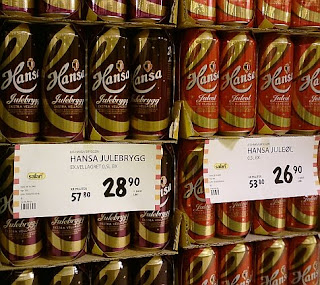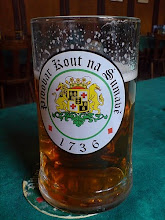 The Czech Beer Festival
The Czech Beer Festival is about to become a tradition. In May the festival will be arranged for the third time, and the arrangers anticipate that 100,000 visitors will attend next year's festival.

In the meantime the arrangers teamed up with several Czech breweries and the
Panorama Hotel to arrange an Autumn tasting at the hotel in the Pankrac neighbourhood of Prague. Depending on what website you visit, the
Autumn tasting or
Oktoberfest in Pankrac was arranged from 2 October to 11 October. The arrangers advertised 14 different draughted beers, Czech food and live music. As I was in Prague at the time, I had to attend the event, and twice I took the metro to Pankrac to enjoy the beers and atmosphere.

As some of you might have read in
my comments on Pivni Filosof's blog, I was mostly positive about the Oktoberfest in Prague. It was a nice opportunity to try various Czech beers, and the food was also very good.

Travelling to Pankrac was easy with the metro. The Oktoberfest itself was being held in a large beer tent near the hotel. I was there on the first night, and at 6PM the tent was nearly full. I went back six days later, and there were even more people there at 5PM. Both days it looked as if people had fun, and it was easy to stay for hours both days. There must have been few foreigners in the tent on both occations, and I only heard Czech spoken around me.

The waitresses did a great job. They were a smiling lot, and I felt very welcome in the beer tent. For payment, you could use the special tolars that were made for the first Czech Beer Festival in 2008. These are worth 40 CZK, and you chose whether to pay in cash or in tolars. A beer always cost a tolar, while you had to pay two or three tolars for most meals on the menu.

On both occations there was music. On the opening night a band played a lot of classic rock and pop songs. I had too much ABBA that night, but there was also another problem: The sound technician had turned the volume much too high. It was more or less impossible to have a conversation in the tent, and I could not enjoy the music. That was a shame, as the band really had some good cover versions of various popular songs.

On my second visit the band was replaced by a duo playing accordion and cornet. The duo played local music, and the only song I recognized was the classic Beer Barrel Polka. I enjoyed this much more than the band on the first night.
There were many opportunities for beers during my visits to Oktoberfest in Pankrac. Unfortunatly, they only sold various lager beers. I would have liked to have a more varied beer menu. The first night I tried the 11° Klášter světlý ležák, the 11° Ježek světlý ležák, the 12° Lobkowicz premium světlý ležák and the Platan 11° světlý ležák. The Klášter golden lager is a personal favourite of mine, and it was the best of these four beers. Platan was OK, while Ježek was a positive surprise that I went on to try several times later during my stay in Prague. Lobkowicz was also OK, but it was beaten by the other three.

The second day I ventured into kvasnicove beers by trying out the Klášter 11° kvasnicový ležák. This was a nice beer, but I prefer the normal version. I should also have tried the Rychtář natur kvasnicový ležák, but I forgot to order it while in the tent. Perhaps that will be for my next time in the Czech Republic? I also tried the 13° Comenius speciál from the Janacek brewery. I believe I was unlucky with the beer I was served, as I felt the stronger lager beer was not very good at all. A metallic taste went to the fore, and I felt it took away all other nuances in the beer. I could not drink all of it. Perhaps it was just being badly tapped?

I enjoyed being at Oktoberfest, and my second visit was the best one. I hope to be back for the beer festival in May, and am looking forward to it if I am able to go. If not, I am back in Prague in March to try some more Czech beers.

 On the streets of the Prague borough of Vinohrady you can find many taprooms and restaurants. One of the more interesting ones is Hrom do Police, because this hospoda sells beers from the Policka brewery. Bars and restaurants offering beers from Policka (or Meštanský pivovar v Policce, which is the full name) are rare in Prague.
On the streets of the Prague borough of Vinohrady you can find many taprooms and restaurants. One of the more interesting ones is Hrom do Police, because this hospoda sells beers from the Policka brewery. Bars and restaurants offering beers from Policka (or Meštanský pivovar v Policce, which is the full name) are rare in Prague. Hrom do Police is a nice cellar restaurant. The name means thunder on the shelves in Czech, but it can also be translated as an idiom meaning an elephant in a glassware shop. Of course, the name is also a wordplay on the brewery name, Policka.
Hrom do Police is a nice cellar restaurant. The name means thunder on the shelves in Czech, but it can also be translated as an idiom meaning an elephant in a glassware shop. Of course, the name is also a wordplay on the brewery name, Policka. On my visits earlier this month Hrom do Police offered five golden lager beers and one dark lager. Their strongest lager is a 12° beer called Zavis. There is also a 11° beer called Otakar, and both beers are also available as yeast beers, kvasnicove.
On my visits earlier this month Hrom do Police offered five golden lager beers and one dark lager. Their strongest lager is a 12° beer called Zavis. There is also a 11° beer called Otakar, and both beers are also available as yeast beers, kvasnicove. I only had kvasnicove beers at the hospoda, and my favourite of them was Otakar. It is served with a large head. There is a lot of carbonation, and I can feel yeast and hints of strawberry in the nose. The beer is fullbodied. It tastes a little bit sweet, and the strawberry notes are more distinct in the mouth. It is a really good beer, and I went back to try it several times. Actually, it was so good that I did not try the ordinary lager version of it from tap.
I only had kvasnicove beers at the hospoda, and my favourite of them was Otakar. It is served with a large head. There is a lot of carbonation, and I can feel yeast and hints of strawberry in the nose. The beer is fullbodied. It tastes a little bit sweet, and the strawberry notes are more distinct in the mouth. It is a really good beer, and I went back to try it several times. Actually, it was so good that I did not try the ordinary lager version of it from tap. The Zavis 12° kvasnicove was also a nice beer, and I have covered it in another post. To sum up: It is an enjoyable beer with hops and yeast notes. In the aftertaste there is much melon. A very drinkable brew, but the Otakar 11° kvasnicove is the better beer according to my palate.
The Zavis 12° kvasnicove was also a nice beer, and I have covered it in another post. To sum up: It is an enjoyable beer with hops and yeast notes. In the aftertaste there is much melon. A very drinkable brew, but the Otakar 11° kvasnicove is the better beer according to my palate. It is also possible to buy bottles of Policka beers to take home from Hrom do Police. Unfortunately, the kvasnicove beers are not available in bottles, but I bought both Zavis and Otakar to try at my hotel. I have lost my tasting notes, but I remember that both beers were very good.
It is also possible to buy bottles of Policka beers to take home from Hrom do Police. Unfortunately, the kvasnicove beers are not available in bottles, but I bought both Zavis and Otakar to try at my hotel. I have lost my tasting notes, but I remember that both beers were very good. I will return to Hrom do Police. I liked the hospoda, but I was also very fond of the Policka beers. The next time around I will try their 10° pale lager and also do a comparison of the different versions of Otakar and Zavis. Perhaps the ordinary lagers are better than the kvasnicove from tap?
I will return to Hrom do Police. I liked the hospoda, but I was also very fond of the Policka beers. The next time around I will try their 10° pale lager and also do a comparison of the different versions of Otakar and Zavis. Perhaps the ordinary lagers are better than the kvasnicove from tap?


































































